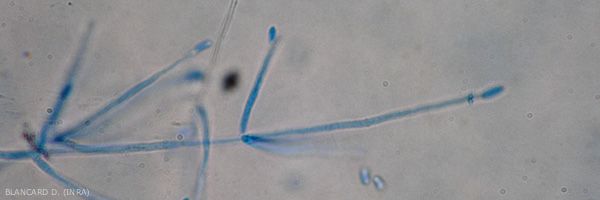
Verticillium dahliae Kleb., (1913)
Verticillium white-black Reinke & Berthold, (1879)
Verticillium wilt
- Classification: Fungi, Basidiomycota, Lichinomycetes, Hypocreomycetidae, Incertae_sedis_, Plectosphaerellaceae
- téléomorphe : Plectosphaerellaceae
- English name: Verticillium wilt
At least two species of Verticillium are likely to attack Cucurbitaceae.
V. dahliae , a highly polyphagous fungus, affects several hundred herbaceous and woody host plants.
it has been reported on many cucurbits in many producing countries in temperate and subtropical zones, especially on crops in open soil, sometimes under cover, infrequently outside soil: melon, cucumber, watermelon, much more occasionally on zucchini and squash. Note that on these last 2 plants, reports of verticillium wilt are recent, in Trinidad and Tobago from 2006, and in Italy a little later. In some plots up to 30% of plants were affected, greatly reducing production. So be careful, this vascular disease may be spreading in some species of the genus Cucurbita Currently, V. dahliae does not seem to affect zucchini and squash crops in France .
This species has several vegetative compatibility groups (VCG), a limited number of them have been demonstrated on Cucurbitaceae. In addition, its pathogenicity appears to vary depending on the strain studied, its original host and its compatibility group. Certain strains present a certain parasitic specificity.
Another more confidential species, V. albo-atrum , is also reported in particular on apricot and cucumber in Iran and California. It has a wide geographical distribution but is mainly observed in temperate regions. Unlike the previous species, it does not form microsclerotia and its thermal optimum is lower. V. albo-atrum , genetically different from V. dahliae , is divided into 2 different groups; group A1 containing a PG1 pathotype (isolated from cucumber) and group A2.





